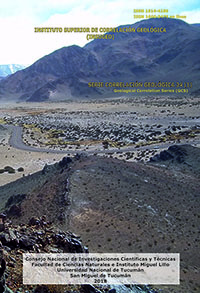Serie Correlación Geológica 34 (1)
El patrimonio geológico y la planificación regional del turismo. Caso: paisajes protegidos de la provincia de Río Negro
Laila Vejsbjerg | Walter Manuel Medina | Guillermo F. Aceñolaza
Descargar trabajo en formato PDFResumen
Se analiza el rol del patrimonio geológico en la innovación y competitividad territorial de destinos intermedios para el turismo, asociados a áreas naturales protegidas (ANPs) provinciales que posean la categoría de manejo de paisaje protegido. El objetivo fue identificar el lugar que ocupa el patrimonio geológico y la geodiversidad en la conformación de sistemas productivos locales o micro-clusters de turismo asociados a paisajes protegidos de dos casos de estudio: Meseta de Somuncurá y Río Limay, provincia de Río Negro, Patagonia, Argentina. Se estudiaron cuatro factores en circuitos turísticos con geositios: vinculación externa, distancia en tiempo de traslado, existencia de plan de manejo y trabajo voluntario, información in situ. Los principales resultados obtenidos fueron: 1. En la oferta turística más consolidada en ambas ANPs el sector privado ha generado sistemas productivos locales o micro-clusters incipientes de turismo; 2. El patrimonio geológico y la geodiversidad quedan soslayados en la interpretación de los paisajes culturales protegidos, aunque se identificaron SIG relevantes. Algunas conclusiones fueron: 1. El patrimonio geológico podría en el corto y mediano plazo constituirse en la base de atractivos secundarios para un territorio intermedio del turismo, y en el largo plazo, convertir a las áreas naturales protegidas periféricas en destinos finales para el geoturismo; 2. Aunque el patrimonio geológico y la geodiversidad son elementos fundamentales para la interpretación de paisajes con escasa intervención antrópica en regiones periféricas, están insuficientemente protegidos bajo la categoría de manejo de paisaje protegido.
Abstract
GEOLOGICAL HERITAGE AND TOURISM REGIONAL PLANNING. PROTECTED LANDSCAPES OF RIO NEGRO PROVINCE CASE STUDY. The role of geological heritage in innovation and territorial competitiveness of intermediate destinations for tourism, associated with the category of protected landscape in protected natural areas (PNAs), is analised. The objective was to identify the place occupied by geological heritage and geodiversity in the formation of local productive systems or tourism micro-clusters associated with protected landscapes of two case studies: Meseta de Somuncurá and Río Limay, Río Negro province, Patagonia, Argentina. Four factors were studied in tourist circuits with geosites: external linkage, distance in time of transportation, existence of a master plan and volunteer work, in situ information. The main results obtained were: 1. In the most consolidated tourism offer in both NPAs, the private sector has generated incipient local productive systems or micro-clusters of tourism; 2. The geological heritage and geodiversity are ignored in the interpretation of protected cultural landscapes, although relevant SIGs were identified. Some conclusions were: 1. The geological heritage could in the short and medium term become the basis of secondary attractions for an intermediate territory of tourism, and in the long term, turn the peripheral natural protected areas into final destinations for geotourism; 2. Even though the geological heritage and geoconservation are fundamental elements for the interpretation of non-anthropic landscapes in peripheral regions, they have insufficient protection under the protected landscape category.






